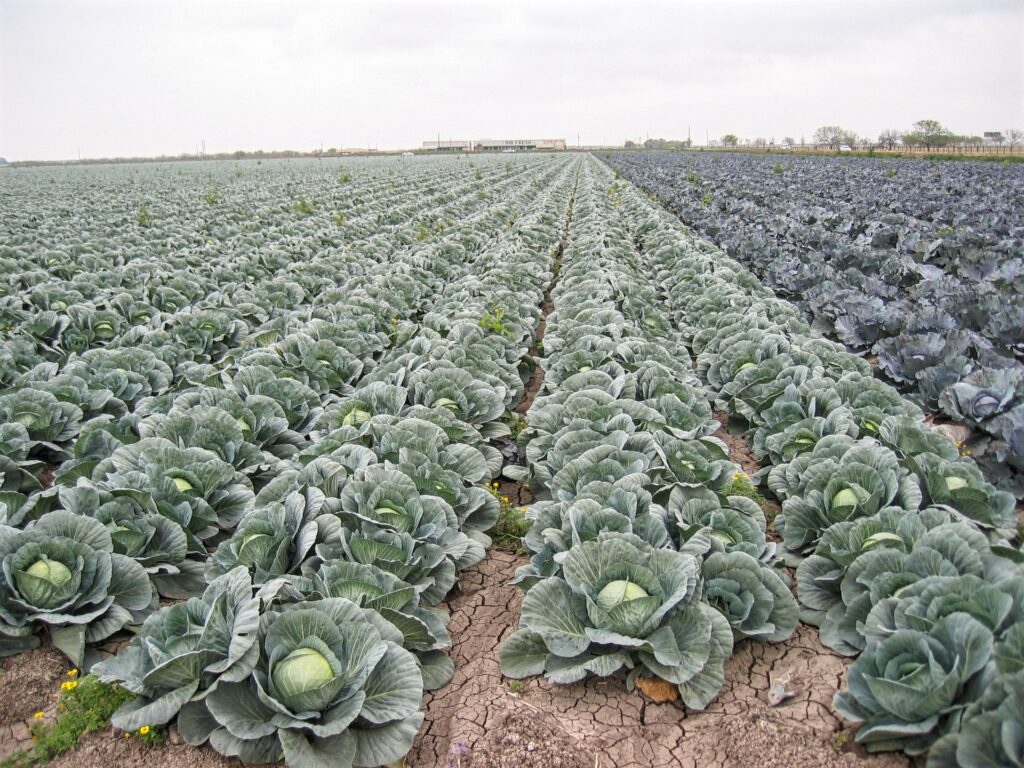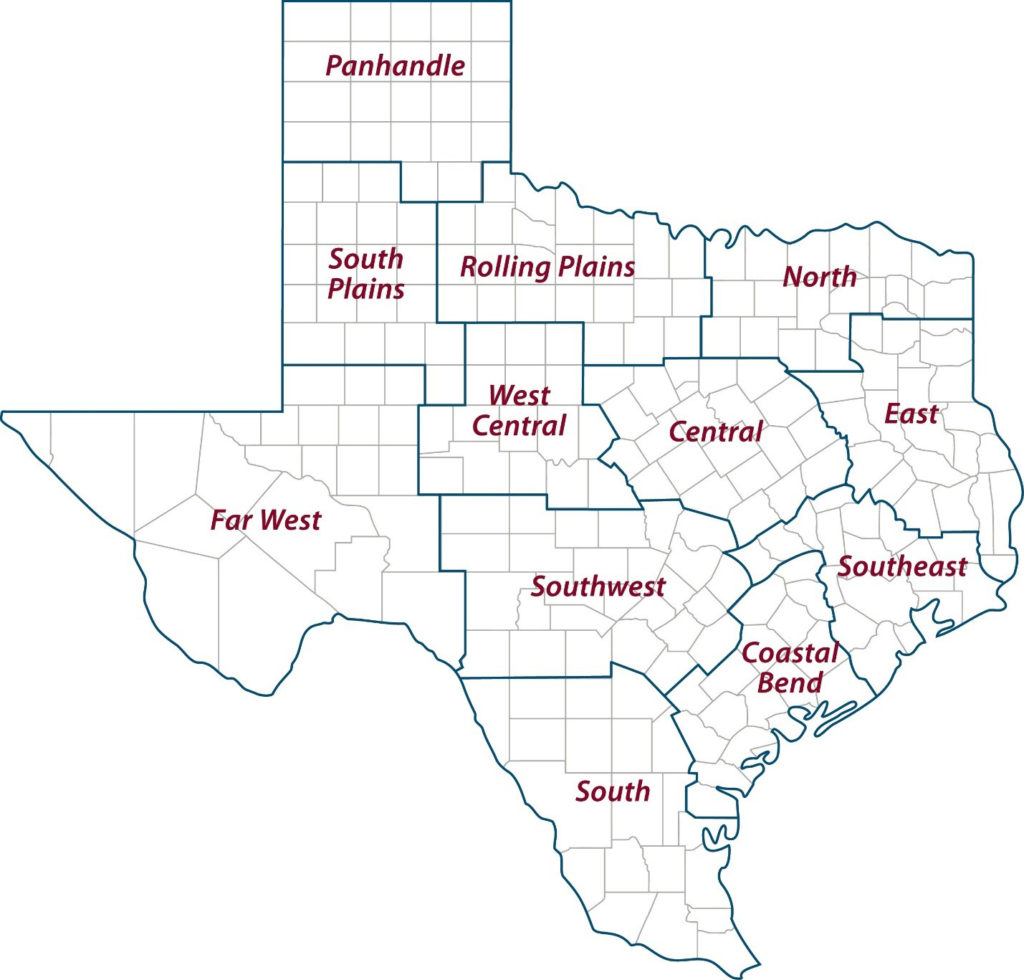Cool-season crops doing well thanks to fall rain
Texas Crop and Weather Report – Feb. 27, 2024
Cool-season crops like leafy greens, carrots, cabbage and onions appear to be producing well as harvest continues, according to Texas A&M AgriLife Extension Service experts. These crops, typically planted from September through February, are harvested from late fall into early spring.

Last year, the second hottest summer for Texas, was followed by a mercifully mild and fairly wet fall, which brought producers some relief and allowed them to plant winter crops. And while the rainfall was too late for the cotton crop in many areas, it gave producers soil moisture needed to establish winter wheat and provided a good start.
Fall rainfall and cooler temperatures allowed many producers in South Texas and the Winter Garden area to plant cool season crops and get root systems established before winter. As a result, the better weather in many areas of the state was a boon for many cool season crop producers.
In the Rio Grande Valley, cool-season crops appeared to be producing average to above average yields, said Juan Anciso, Ph.D., horticulture program leader and associate head of the Texas A&M Department of Horticultural Science based at the Texas A&M AgriLife Research and Extension Center at Weslaco.
Anciso said most South Texas producers rely solely on irrigation from the Rio Grande River. The lack of rain and subsequent reliance on irrigation can be a good thing by curbing pest and disease issues, but irrigation rations have become a concern over the past two seasons.
“Onions and leafy greens have been growing well, but we have seen an increase in disease in both crops as a result of recent rains,” Anciso said. “Onions will be harvested in mid-March while leafy greens are in the process of being harvested now.”
Conditions, yields look good for cool-season crops
Cabbage is growing well despite some general lepidopteran worm pressure, Anciso said. Most pest issues were under control in those fields, and harvest has begun. Carrots have not shown any notable pest or disease pressure and are being harvested as well.
“We’re off to a good start, but it’s too soon to know for sure,” he said.
Larry Stein, AgriLife Extension horticulturist based in Uvalde, reported similar conditions in the Winter Garden region. He said onions there were faring well despite a few bouts with colder weather earlier this year.
Stein said spinach acres in the region remained steady to slightly higher this year, and processing yields have been good to this point.
“Fresh market spinach yields are good with excellent quality, but demand is off a bit compared to recent years,” he said.
Stein said the cabbage crop in the South-Central Texas area has been steady to good and yields have been decent.
“Demand has been good, but is currently down a bit just now,” he said. “However, there will likely be a rebound on the demand for cabbage as we get closer to St. Patrick’s Day.”
AgriLife Extension district reporters compiled the following summaries:
Central
Weather conditions were unseasonably warm with little rainfall. The soil moisture was good. Additional rain was needed to fill tanks and natural bodies of water. Native pastures looked better. Farmers were preparing to plant spring crops, and some began planting corn. Wheat and oats held up despite grazing. Stripe rust was found in limited fields, with incidence and severity remaining low at that time. Hessian fly remained present. The warm weather increased fly numbers on livestock. Livestock remained in fair to good condition. The early February rains and warmer temperatures gave ranchers a respite from heavy supplementation, but some livestock supplementation continues.
Rolling Plains
The district was enjoying unseasonably warm and mild weather for February. Conditions remained favorable for good growth of wheat, pastures and rangelands. Cattle were benefiting from the good grazing. Producers were hoping for more rain soon to sustain the wheat crop, and for more grass growth and better soil moisture for spring planting.
Costal Bend
Weather conditions varied, with windy conditions accelerating topsoil moisture depletion, followed by drying conditions and unseasonably warmer weather facilitating planting progress. Crop planting activities were underway, with field crop producers initiating corn planting in drier sandy fields. In Nueces County, favorable planting conditions supported excellent progress for all crops, including corn, sorghum and cotton. Similarly, Refugio County initiated corn and milo planting amidst mild temperatures and decreasing rainfall. Pasture conditions were improving across the region, with annual winter pastures sustaining cattle grazing operations and pastures growing rapidly with warmer weather. Livestock producers continued supplemental feeding amidst hay consumption slowdowns. Cattle maintained good condition and cattle prices remained high on lower inventories, contributing to strong livestock markets.
East
Recent warm temperatures have allowed pastures and forages to begin greening up and growing well. Trees were blooming. Pre-emergent weed control has been placed out. Pasture and rangeland conditions were poor to fair. Subsoil and topsoil conditions were adequate. Jasper County reported a few incidents of fire. Houston County reported cattle prices gained strength, with all weight classes ending $7-$10 higher. Livestock were in fair to good condition as producers continued supplemental feeding.
South Plains
Producers were busy preparing equipment for the planting season. The district was drying up from the recent snowstorm, and many fields were dry enough to bring in equipment. Cattle were in good condition as producers continued supplemental feeding. Winter grazing was in fair to good condition.
Panhandle
The Panhandle region remains dry. Warm, sunny conditions persisted for most of the week, allowing for quicker heat units accumulation. Grass and small grain crops planted for seed, forage and cover were expected to grow faster, but there may be greater evapotranspiration. Additional precipitation was needed to meet this demand. The same principles hold for native and improved grass pastures. Rangelands and pasture grasses remained dormant. Preplant activities occurred for corn, cotton and grain sorghum. There was top dressing and weed control in wheat. Supplemental feeding continued for cattle.
North
Most of the district experienced unseasonably warm and windy weather that dried the surplus topsoil moisture. Temperatures were in the mid-70s. Summer grasses were beginning to emerge from dormancy with the higher temperatures. Wheat and other cool-season crops were growing rapidly. Fields were in good to excellent condition. Livestock were in good to excellent condition.
Far West
Temperatures were unseasonably warm over the past week, with a high of 85 degrees and a low in the 50s through the night. Conditions continued to dry and strong winds persisted. The drought took a toll on wheat as most fields were dying despite some decent rains in September and October. Producers were starting to get seeds in the ground. Topsoil moisture was good but subsoil moisture was nonexistent. Rangeland conditions were drying out with only slight new grass growth. Lambing and kidding season continued. Livestock were in fair condition as producers continued supplemental feeding.
West Central
The district was swept with unseasonably warm days with a need for rain. Temperatures reached a high of 85 degrees. Strong winds dried out subsoil and topsoil moisture during the warmer days. Small grains were slowly growing. Some field preparation for spring-planted forages began. Warmer temperatures allowed some ornamental trees and shrubs to bloom. Corn was being planted slowly. Winter wheat was making good progress. Lake and pond levels continued to drop. Cows were calving and in good condition as producers continued supplemental feeding.
Southeast
Recent rainfall and warmer temperatures allowed pastures to continue greening up. The ponds were full. Ryegrass continued growing. Corn planting was being completed. Rice was expected to be planted early in Jefferson County. Soil moisture levels throughout the district ranged from adequate to surplus. Cattle markets held strong, with prices continuing to climb.
Southwest
It was another dry and windy week, with temperatures ranging from the 70s to the 90s. Pasture and rangeland conditions showed slight improvement from recent moisture, but dry conditions returned as temperatures began to rise. Moderate temperatures indicated potential favorable conditions for continued cool-season crop plantings. Warmer weather encouraged grasses and forage to grow, but the temperature increase also began to dry out the soil. Row crop production was set to start soon, and pecans were expected to begin budding shortly. Corn planting commenced. Plants and vegetable crops were starting to recover from last month’s freeze. Livestock conditions were fair to good as producers continued supplemental feeding. Lambing and kidding were underway.
South
Warm weather encouraged pastures and rangelands to green up and trees to bloom. Producers started planting corn and preparing fields for peanut and cotton planting. Strawberries were producing well. Spinach and cabbage production was coming to an end. Wheat, oat and rye fields were improving. Topsoil and subsoil conditions were adequate due to recent rainfall. Hay prices were still high. Although supplemental feeding continued, producers also started turning livestock on rangelands and pastures. Cattle prices were firm at local markets. Wildlife was very active.






